Euromaidan
In the evening of November 21, 2013, the first protesters appeared on Maidan Nezalezhnosti in the centre of Kiev (literally the Independence Square). A journalist Mustafa Najem was the one to start the action in the social media. The demonstrators demanded the President Viktor Yanukovich to sign an association agreement with the EU. Yanukovych was to sign the agreement during the Eastern Partnership summit in Vilnius in November 2013. However, despite many months of preparations, he finally refused to sign the document. On November 21, the then Prime Minister Mykola Azarov issued a regulation to suspend preparations of finalisation an association agreement with the EU.
- When I saw Azarov's statement, I ran to the Parliament and I met Yatsenyuk and his bodyguards there. I was very angry, and I might have behaved the way a journalist should not. I told him that he might have to call people to protest today, although the meeting was scheduled for Sunday. Yatsenyuk was sceptical about it. Then I wrote the first post about the then anniversary of the Orange Revolution. There were many negative comments about our authorities under that post. And then I just asked the question: “are you ready to go out on the streets now and will a thousand people gather?” 600 people declared after an hour. I did not wait any longer, this number made a huge impression on me. I came to Maidan Nezalezhnosti around 10.15 p.m. and there were about 30 to 40 people. I thought: “ok, what can I do, maybe we will celebrate the anniversary of 2004 at least”. However, some people with megaphones soon began to appear. At midnight there were already a thousand of us and it was a shock for me - Mustafa Najem recalled two years ago the beginnings of Euromaidan.
It was the reason that led to the demonstrations, although since the beginning of the presidency of Yanukovych there was growing opposition to its authoritarian methods of ruling.
The most numerous group of protesters at the beginning of Euromaidan were students.
On the night of November 30, they were brutally beaten by the militia. On December 1, several thousand-people gathered in the centre of Kiev. There were clashes on Bank Street. Berkut brutally pacified the protesters. There were several dozen journalists among the wounded ones.
From that moment the rebellion started to be aimed directly at Yanukovych and his political allies. The protests were called the Revolution of Dignity.




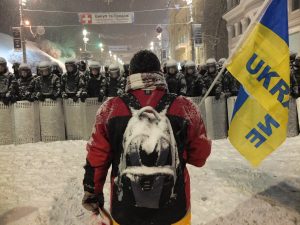 The behaviour of protesters became more radical. The brutality increased on the side of the regime forces. First demonstrators were killed in January on Hruszewski Street.
On February 18, there was a fight between the protesters and Berkut in front of the Supreme Council of Ukraine. The street riots covered the central streets of Kiev. Demonstrators retreated to Maidan Nezalezhnosti, which was stormed by Berkut and internal troops.
The behaviour of protesters became more radical. The brutality increased on the side of the regime forces. First demonstrators were killed in January on Hruszewski Street.
On February 18, there was a fight between the protesters and Berkut in front of the Supreme Council of Ukraine. The street riots covered the central streets of Kiev. Demonstrators retreated to Maidan Nezalezhnosti, which was stormed by Berkut and internal troops.
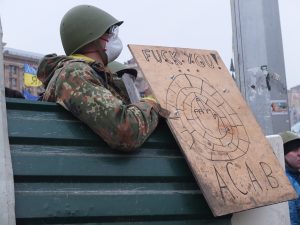




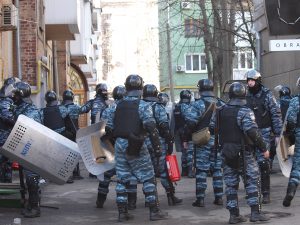










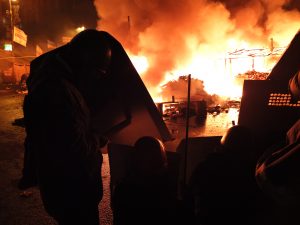
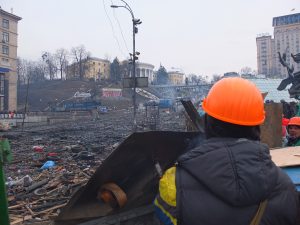


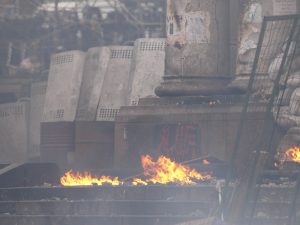




 In the morning of February 20, Berkut opened fire using sniper and automatic weapons. 75 people were shot at that time. There was also at least one shooter on the side of demonstrators. He could shoot two Berkut officers and injured several militiamen using Kalashnikov.
In the morning of February 20, Berkut opened fire using sniper and automatic weapons. 75 people were shot at that time. There was also at least one shooter on the side of demonstrators. He could shoot two Berkut officers and injured several militiamen using Kalashnikov.



 21 lutego z rezydencji pod Kijowem w Meżyhirii uciekł do Rosji ówczesny prezydent Ukrainy Wiktor Janukowycz. Obecnie w Kijowie trwa jego proces.
https://content.outride.rs/en/yanukovychs-trial-has-started/
Szacuje się, że łącznie, podczas trwania Majdanu, zginęło 128 osób, przede wszystkim nieuzbrojonych protestujących, ale też 16 milicjantów i żołnierzy wojsk wewnętrznych.
21 lutego z rezydencji pod Kijowem w Meżyhirii uciekł do Rosji ówczesny prezydent Ukrainy Wiktor Janukowycz. Obecnie w Kijowie trwa jego proces.
https://content.outride.rs/en/yanukovychs-trial-has-started/
Szacuje się, że łącznie, podczas trwania Majdanu, zginęło 128 osób, przede wszystkim nieuzbrojonych protestujących, ale też 16 milicjantów i żołnierzy wojsk wewnętrznych.
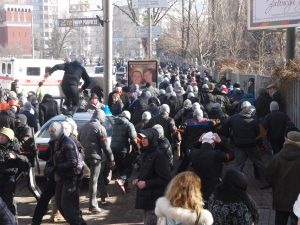






 The behaviour of protesters became more radical. The brutality increased on the side of the regime forces. First demonstrators were killed in January on Hruszewski Street.
On February 18, there was a fight between the protesters and Berkut in front of the Supreme Council of Ukraine. The street riots covered the central streets of Kiev. Demonstrators retreated to Maidan Nezalezhnosti, which was stormed by Berkut and internal troops.
The behaviour of protesters became more radical. The brutality increased on the side of the regime forces. First demonstrators were killed in January on Hruszewski Street.
On February 18, there was a fight between the protesters and Berkut in front of the Supreme Council of Ukraine. The street riots covered the central streets of Kiev. Demonstrators retreated to Maidan Nezalezhnosti, which was stormed by Berkut and internal troops.

























 In the morning of February 20, Berkut opened fire using sniper and automatic weapons. 75 people were shot at that time. There was also at least one shooter on the side of demonstrators. He could shoot two Berkut officers and injured several militiamen using Kalashnikov.
In the morning of February 20, Berkut opened fire using sniper and automatic weapons. 75 people were shot at that time. There was also at least one shooter on the side of demonstrators. He could shoot two Berkut officers and injured several militiamen using Kalashnikov.



 21 lutego z rezydencji pod Kijowem w Meżyhirii uciekł do Rosji ówczesny prezydent Ukrainy Wiktor Janukowycz. Obecnie w Kijowie trwa jego proces.
https://content.outride.rs/en/yanukovychs-trial-has-started/
Szacuje się, że łącznie, podczas trwania Majdanu, zginęło 128 osób, przede wszystkim nieuzbrojonych protestujących, ale też 16 milicjantów i żołnierzy wojsk wewnętrznych.
21 lutego z rezydencji pod Kijowem w Meżyhirii uciekł do Rosji ówczesny prezydent Ukrainy Wiktor Janukowycz. Obecnie w Kijowie trwa jego proces.
https://content.outride.rs/en/yanukovychs-trial-has-started/
Szacuje się, że łącznie, podczas trwania Majdanu, zginęło 128 osób, przede wszystkim nieuzbrojonych protestujących, ale też 16 milicjantów i żołnierzy wojsk wewnętrznych.







